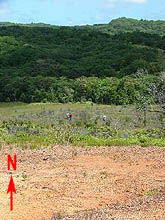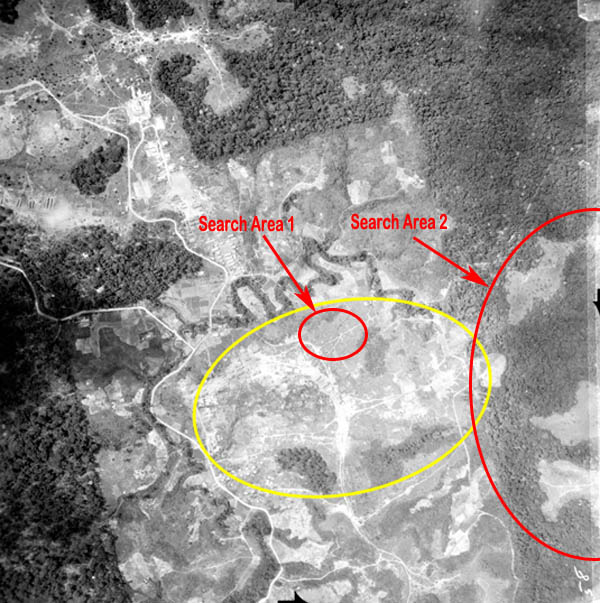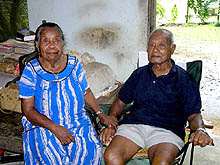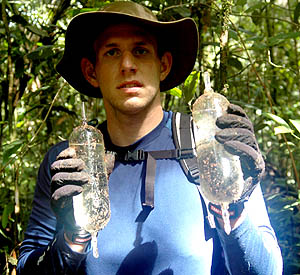P-MAN
VII Final Report ATTACHMENT 8 Continuing the search for POWs in Ngatpang area, both on Police Hill (Search Area 1, based on new findings, 23FEB05) and on adjoining hills (Search Area 2, based on new input from Palauan elder, 12-13MAR05) (see P-MAN II, P-MAN III, P-MAN VI reports), The search by the BentProp Project for POWs in the Ngatpang area has evolved from a very simple story (in which we felt we had no chance of finding the MIAs/POWs) to a very complex detective mystery (where we still feel the odds are against us). However, just maybe, we may be making progress. On 23FEB05, we borrowed the SUV from Sam's Tours and drove up the west side of the Compact Road on Babeldaob to Gasupan Hill (aka Ngatpang Hill, Police Hill). Several Japanese and Palauan reports indicate that, in this general area, Japanese military executed American POWs (a minimum of three and possibly more than ten airmen and up to three sailors (UDT Team 10)) and ten catholic civilians, as reported in the War Crimes Tribunal testimonies and elsewhere. Executions of other foreigners (e.g., from India, Formosa, China, Korea) also have been reported. Considerable efforts to find the executed POWs in this area have already taken place. In 2000, then CILHI (US Army Central Identification Laboratory, Hawaii) initiated a search in the area (See P-MAN II report), which was followed by another CILHI search in 2001, during which an eyewitness pointed out a specific area as a possible burial spot (See P-MAN III report). In 2004, during P-MAN VI, JPAC returned with a recovery team and exposed an extensive area to the north of the Police HQ (See 8-10 below), without discovering evidence of remains. An unresolved issue is whether or not the actual burial sites have been correctly identified to date. Search Area 1 During P-MAN VII, we investigated two new areas for two different reasons. On 23FEB05, in Search Area 1, we spread out and searched north and slightly east of the prior JPAC effort. We found, in areas we believe not previously described, both depressions and dug out holes, which had dimensions consistent with grave sites. At the extreme of our search northward, we found remnants of a house foundation.
The photograph from Bishop Museum (8-7A) is very revealing and the series we now have is the subject of our intense study. However, even a casual look at the photo reveals that the Ngatpang Hill area was covered with Japanese structures. Today, with the exception of an occasional structural foundation, virtually nothing remains of these buildings. What makes these photographs valuable is that the War Crimes Tribunal records contain maps hand drawn by Japanese military prisoners revealing execution sites. These drawings have not been interpretable because of the inability to link structures present in 1944-45 to today's absence of such structures. These newly found photographs may finally allow the drawings to yield their secrets. The photographs may also help re-orient the memories of Palauan elders who know something about this area and its history (see below).
Search Area 2 We initiated Search Area 2 for a very different reason. As part of our village-to-village elders interview tour of Babeldaob, on 12MAR05 we visited Chief Techitong and his wife. I had met him in 2000 during my first meeting with all Ngatpang chiefs in our search for LTGEN Inoue's jungle headquarters (See P-MAN II report). What we thought would be a brief courtesy call turned into a two hour (videotaped) interview.
Briefly, Chief Techitong was drafted (instead of his father) by the Japanese military during their occupation of Palau. As a conscript, from time to time he was called to witness executions (usually beheadings) of slave laborers from Korea, Okinawa and Formosa. Before the aerial attacks by the Americans began (Desecrate One, MAR44), the executions took place generally in the area described by other Palauans and searched by CILHI and JPAC (i.e., Police or Gasupan Hill). However, according to Chief Techitong, once the Americans started attacking the Ngatpang area, the Kempeitai (Japanese Army military police - separate from both the Imperial Japanese Army forces in Palau and the Japanese navy military police, the Tokkeitai) moved their headquarters and jail from the open area on the hilltop into the adjacent jungle valley to the east and stayed there for the duration of the war. He also said, as a result of the move, the execution area changed, to a ridge "less than one hour" (by foot) north of and behind the jungle hospital across the river from the original buildings. The ridge was also "not too far from the old village" (possibly Ngat). He specifically recalled the execution area and described it as being on a ridge, with a deep hole around which were placed four stones. Prisoners stood on the stones, facing outward and then were beheaded in such a manner that they fell into the common grave; to fill the grave uniformly, prisoners were rotated from stone to stone. Although he did not know how many executions took place, he said there were many. When asked if he saw Americans executed, he said he did not, although he believes Americans were also executed at that site. He believes the execution site, if found, should contain 1-4 Americans and the priests, along with the executed slave laborers (this appears to be a very different story gained from review of the War Crimes Trials testimonies of Japanese prisoners). He said he was very pleased that we had found him, as he was eager to share what he knew with us. Because Chief Techitong said that the jungle hospital was on the way to the execution site, on 13MAR05 we hiked into the jungles to find the hospital in preparation for P-MAN VIII. He said the wood structure had decayed long ago but some evidence should still be present. Within an hour in the jungle, we were able to locate medical paraphernalia in a defined region just east of the river. We found many sealed glass ampules, large and small, some with colored fluids, some clear. Several large sealed vessels probably contain saline (and would still be sterile and effective today). As a physician, I had never seen such sealed vessels for intravenous fluids, but in that era and jungle environment, they would have been quite practical. We did not search the area extensively but found a variety of items (undoubtedly with much more to be found), all of which were consistent with a hospital - and right where the chief had told us to look. Because we were under dense jungle, we once again had a difficult time getting a GPS reading. But Mike Olds, being the youngest and the tallest person, became a fine antenna holder and we obtained the waypoint.
We then extended our search further through the jungle, uncovering numerous abandoned military sites (e.g., a small supply dump, a 3x3x5 foot ash-filled oven, sealed caves, open caves). Ultimately we walked up two ridges, one to the north of the hospital and one to the southeast. The area to the north has evidence of an old road leading north. The other area has minimal evidence of human presence. These two ridges appear to be two of at least four ridges in the immediate area that could match up with the ridge described by Chief Techitong. We found no place with four large stones, although we now have a much better idea of how to prepare for future searches in this area. It is clear from an afternoon of searching that this area was heavily occupied by Japanese military forces during the war and much of their non-mobile equipment was abandoned in place. From this, we feel Chief Techitong's recollections deserve serious consideration in the continued search for these still-missing POWs.
Working Conclusions: During P-MAN VII, we located at least two
new areas which may be possible execution/burial sites in the Ngatpang area. Adding
these two with prior findings from P-MAN II (General Inoue's "jungle headquarters")
and P-MAN V (at least one additional Japanese cemetery (still occupied) and General
Inoue's "jungle house"/Command Post), the BentProp Project team is in
process of developing a plan for evaluating each as a potential execution site.
For example, several elements of Chief Techitong's description match LTGEN Inoue's
Jungle HQ quite closely (See the P-MAN II report,
which describes a flat depression on a ridge top at Inoue's HQ, due north of Hospital,
possibly within an hour's jungle walk). P-MAN VII's Search Area 1 will require
assessment by a qualified archeologist/forensic anthropologist, while Search Area
2 will require much more field work to locate a possible site, as several ridges
are in the area east of the river. Critical to the success of finding anything
in Search Area 2 will be taking Chief Techitong to Gasupan Hill and having him
point out key areas/directions to investigate. The possibility remains that more
than one execution site may have been used - if we can locate just one of these
sites, we will have been successful. |
| |
|
| Page last modified 23 August 2005 | |




